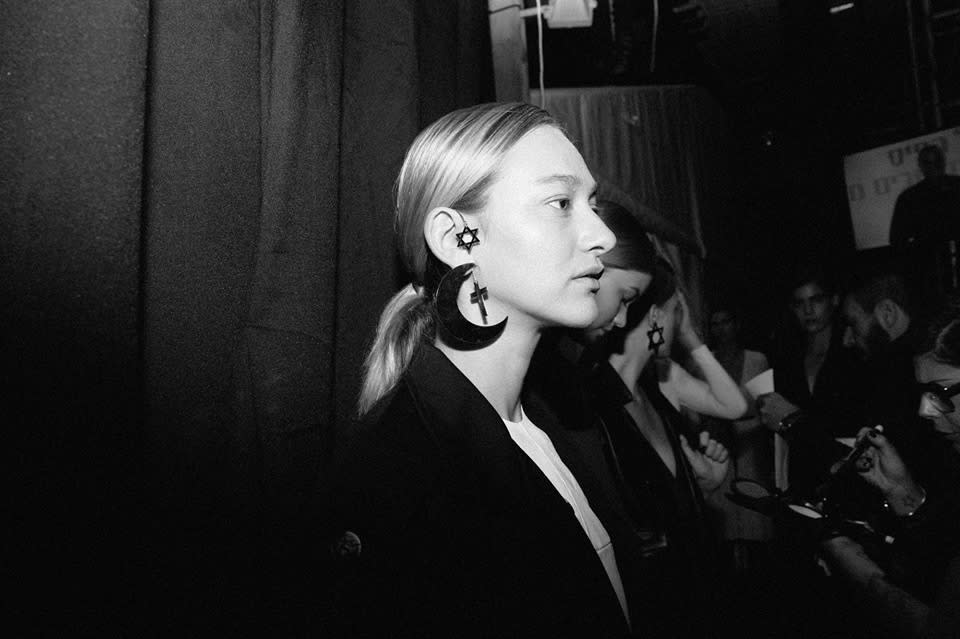Fashion in the Time of War: Israel Fashion Week Goes Off With a Bang (Not Literally)

Rachel Cohen’s Common Raven earring combines the Islamic crescent moon, Jewish Star of David, and a Christian cross. Photo: Common Raven/Facebook
In East Jerusalem, Israeli and Palestinian tension continues to mount, as usual. With constant death on both sides of the conflict, citizens throughout the region are on high alert for everything from knife attacks to bombings; the current wave of violence is just the most recent escalation of a terror that’s wormed its way into daily life. And yet, that daily life continues—even when it comes to fashion.
While United States Secretary of State John Kerry met with Israeli Prime Minister Benjamin Netanyahu and Palestinian President Mahmoud Abbas in Berlin, Gindi Fashion Week took place in Tel Aviv. It was, in fact, the biggest and splashiest one since the Jewish state started hosting its own fashion week in 2001. Bar Refaeli and influential bloggers kicked things off with an opening gala; young audience members dressed up like they were attending the coolest bat mitzvah in town only to sit in the back row; and a corporate sponsor added major production value to the runways.
Thirty designers presented their Spring/Summer collections over four-days. A number of them having established brands already, both widely recognized within the country and internationally such as Gideon Oberson and Dodo Bar Or, but most would fall into the emerging category; some were even students.
Since September, runway after runway has shown ruffles, crop tops, and mesh, which is monotonous for even the biggest fashion fan. But as one of the last stops on the Fashion Week train, showing long after most editors have returned home, Israel’s offerings managed to make an impression. Customers will clamor for Ricardo Tisci’s Givenchy regardless of whether it’s shown in Paris or New York, but Israel’s unique in that the clothes are so much of the place.
“What makes Israeli fashion so special is actually a combination of elements,” says Danielle Jacobson, a student in Shenkar College’s Fashion Design Department (Business of Fashion recently ranked it the fifth most influential fashion school in the world). “Israel is a melting pot for many cultures and living here has never been easy. The weather, the people, the conflicts, and our hot temperature are some of the things that make Israeli designers different, and bring an added value to their work.”
Even from an outsider’s perspective, the country’s fashion sense has a desirable and enviable element to it. Hannah Deoul, a 23-year-old American who spent the last year in Israel teaching lacrosse to young girls, says that both the women and men have amazing, casual style that makes tourists and visitors stand out. It’s this specific look—tan skin, impeccable hair and makeup, and yet not a care in the world—for which designers are creating.
Rachel Cohen, the woman behind 4-year-old indie label Common Raven, showed her collection for the first time last week. “I’m very interested in the local customer so I am trying to bring something different for her,” she says. “I’m trying to elevate it a little bit, a little more sexy, more dressy, hopefully it will work!” Her inspiration comes from religion, which might sound obvious in Israel, but not just Judaism. From Islam to Christianity, Cohen’s interested in the way people use clothes to express their beliefs. Models wore crescent moon, Star of David, and cross-shaped earrings paired with flowing dresses, leather jackets and motorcycle boots. Designer Yaron Minkowski, who also showed this past week, draped keffiyeh, the Arab headdress that offers protection from the dessert’s sand and hot sun, on models. The scarves were imported from Hebron in Palestine, where they are a symbol of nationalism, and made into black and white and red and white dresses.
“Everything in Israel is new; you can’t get it anywhere else. People are truly pioneering all the time here,” Cohen says. And she’s not just talking about fashion; the tech scene is also taking off (the merging of the two produced the first 3D printed fashion collection). “The people, the closeness, the familiarity — they feel really confident in things and clothes.”
More than 1,200 people attended each of the shows, with foreign buyers in the audience expressing interest in what they saw. While all signs point to the country’s emergence as a promising talent incubator, the industry’s not ignoring what’s happening beyond the shows. “It takes last place on the list of priorities,” Cohen admits. “Over the years it’s gotten to be a little bit more important. I mean people won’t look at it as they do anywhere else because we have a lot on our minds, you know everything is taking your mind off of it. It’s very difficult to focus only on fashion.” Even Jacobson, who’s about to graduate, isn’t set on building her career in her home country. “Living here is not easy,” she says. “Apart from the obvious hardships, Israel is becoming more and more expensive and unfortunately the fashion industry has no backing. Young designers are struggling to make it on their own without financial help from the government and the industry.”
Will Tel Aviv Fashion Week be back in February? It’s too soon to tell. But fans — nearly 100,000 of them — and designers are praying for its return. “Hopefully it will continue,” Cohen says, “but here, you can never know.“
Follow us on Instagram, Facebook, and Pinterest for nonstop inspiration delivered fresh to your feed, every day.

